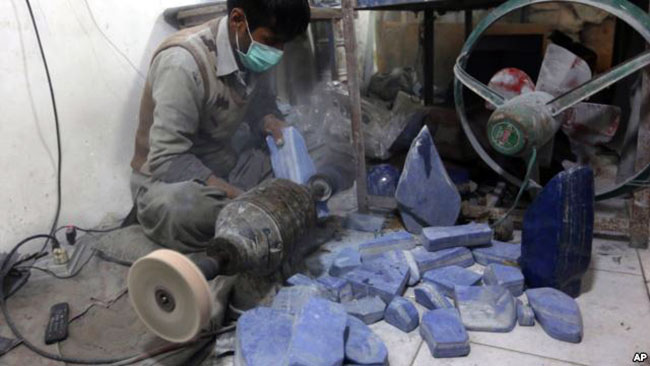KABUL - A new investigation has revealed how Afghanistan's multi-billion dollar lapis mines are driving corruption, conflict and extremism in the country.
According to Global Witness the Taliban and other armed groups are earning up to $20 million USD dollars a year from Afghanistan's lapis mines.
In a statement issued by Global Witness it said: "As a result, the Afghan lapis lazuli stone should now be classified as a conflict mineral.
The lapis mines are in the Badakhshan region, once one of the more stable areas in Afghanistan, even at the height of Taliban control. However, violent competition for control of the lucrative mines and their revenue, between local strong men, local MPs and the Taliban has deeply destabilized the province and made it one of the hotbeds of insurgency.
Global Witness' investigation also includes evidence that the Badakhshan mines are a strategic priority for Daesh.
"Unless the Afghan government acts rapidly to regain control, the battle for the lapis mines is set to intensify and further destabilize the country, as well as fund extremism," read the statement.
Mining in the country is the Taliban's second biggest source of income next to opium.
Afghanistan's mineral wealth is estimated to be over a trillion dollars' worth of mineral, oil and gas deposits, which could provide the government with over $2 billion USD in revenue a year, if developed properly.
"But rampant corruption and a failure to secure mining sites means that mines have been targeted by insurgent groups and are now a major contributor to conflict and extremism. The new Afghan mining law, which is currently being amended by the government, fails to include the actions needed to counter this threat," the report warns.
"These lapis mines are one of the richest assets of the Afghan people and should be driving development and prosperity," said Stephen Carter, Afghanistan Campaign Leader at Global Witness.
"Instead, the beautiful lapis lazuli stone has become a conflict mineral. The mines provide a tiny fraction of the benefit they should, and have become a major source of conflict and grievance, which is driving the insurgency and undermining hope for stability in Afghanistan – which could have consequences globally."
"Unless the Afghan government acts quickly, these mines represent not just a lost opportunity but a threat to the future of the whole country," said Carter.
"The Afghan government must urgently re-establish the rule of law at these mine sites, and strengthen oversight and transparency for mining across the country to make sure these natural resources serve the Afghan people to whom they belong."
Global Witness called for the Afghan government and its international partners to make problems around mining in Afghanistan a critical priority in order to tackle the crisis.
In particular, the current mining law fails to put in place the fundamental safeguards of transparency, accountability, and community engagement that are needed to secure and develop Afghanistan's mining sector, they said in their statement.
Global Witness is calling for the government to ensure publication of mining data, reform mining oversight, and support community monitoring of mining.
"Governments around the world need to wake up to the fact that Afghanistan's mines are driving conflict in the country and do something to stop this before even more of the mines falls into the hands of insurgents and armed groups," said Carter.
Global Witness says not only are the Taliban continuing to profit from the illegal mining of lapis and other jewels in Badakhshan, but that senior players in the Afghan government may have direct involvement.
But Gul Mohammed Bedar, a deputy governor of Badakhshan, denied allegations that government officials had their fingers in the illicit trade, but confirmed that the lapis mines are controlled by "illegal armed groups" as well as the Taliban, making it difficult for the government to manage.
Lapis mining was outlawed last year, but the mines now lie in a lawless region controlled by the Taliban and warlords of varying allegiances.
Much of the illegal lapis is being smuggled out through neighboring Panjsher province, according to officials, home to some of Afghanistan's most powerful players.(Tolonews)
Home » Afghanistan » Afghan Lapis Driving Conflict: Watchdog
Afghan Lapis Driving Conflict: Watchdog

